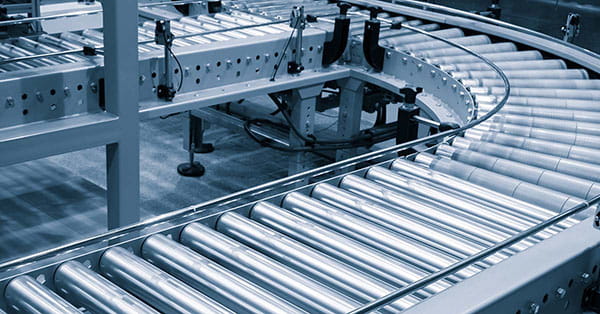Alabama Conveyor Systems Supplier
AS/RS systems and conveyors can elevate the efficiency of your warehouse, enhance warehouse safety and substantially reduce labor expenses.
Today’s conveyor systems can move everything from heavy pallets to small packages within your warehouse, and they are a fundamental piece of modern material handling design.
Conveyors can be grouped in three distinct categories for almost all material handling configurations:
- Powered roller or belt conveyors (for carton handling)
- Powered roller or chain conveyors (for pallet handling)
- Non-powered conveyor systems
Powered Package Handling Roller or Belt Conveyors
Powered roller or belt systems are generally used for less bulky pieces like packages and cartons.
Belts are usually used for moving products along a line, while roller systems are used for accumulating products in specific areas along the line.
Belt Conveyors
Used since the beginning of the 20th Century, belt conveyors are a fundamental part of most material handling configurations. Less expensive than roller options and often more appropriate for specific tasks like transporting lightweight products, belt conveyors are used in many material handling configurations.
Belt conveyors feature a long, looped belt that sits atop a metal slider belt substructure or an array of non-powered rollers. A motor drives a pulley that turns the belt and advances objects down the conveyor line.
Conveyor belts can be configured with an assortment of surfaces and materials depending on the function and role of the conveyor. For instance, a conveyor belt surface could be perfectly smooth in portions where products need to glide off the line and may have a gripping texture on segments where goods must be moved up gradients.
Roller Conveyors
Despite the long and successful history of belt conveyors, newer roller conveyors offer a number of advantages in many modern material handling uses.
Principal among these, roller systems can allow for accumulation of objects on the line where belt conveyors cannot. This is a critical distinction because there are countless scenarios where objects must hold and accumulate in material handling configurations. Accumulation is often necessary when items must be paused before being relayed to automated palletizers or sorters.
Some roller conveyor systems also have the capacity to monitor objects on the line and implement zero pressure accumulation, meaning none of the amassed objects come into contact as they slow down and come to a stop.
Roller systems are made up of numerous cylinder rollers that are usually powered in one of three different ways:
- Line shaft conveyors: in a line shaft system, a long steel rod runs underneath the rollers at a right angle to them and is attached to each roller with flexible O-rings. A motor rotates the shaft and accordingly drives the cylinders by way of the attached O-rings. Line shaft configurations are the least costly of all roller style conveyors, but they also require the most repair because the O-ring connectors between the shaft and rollers tend to need adjustment and often break.
- Belt-driven roller conveyors: As you may expect, these systems are powered by a belt that lies underneath the roller platform. A motor propels the belt, which advances the cylinders.
- MDR conveyors: Motorized roller conveyors, frequently called motor-driven roller (MDR) systems, are set up in sections where only one cylinder from each segment is propelled by ’its own motor. That individual motor-driven cylinder is linked to the others in that section via flexible O-rings, thereby rotating all the rollers in the segment. MDR units are positioned in sequence to configure the conveyor line.
MDR systems are known for their energy efficiency because: a.) They generally are powered by 24-volt direct current motors and b.) The motors can be configured to run only when an object is present on the cylinders, and as a result they are inactive most of the time.
Although motorized roller conveyors cost more than line shaft and belt drive systems, energy costs and maintenance outlays are typically much lower than the other types of conveyors. - Segmented belt conveyor: The concept of motor-driven roller systems eventually inspired the development of segmented belt conveyors. Similar to MDR systems, segmented belts function individually and feature a lot of the same benefits of motor-driven rollers, including accumulation capacity.
Powered Pallet Handling Conveyors
Powered pallet handling conveyors are frequently coupled with automatic palletizers and AS/RS setups. Pallet handling conveyors can usually accommodate pallets of up to two tons and proceed at a much slower rate than carton handling conveyors, often at speeds as low as four pallets per minute.
Pallet handling conveyors come in one of two types: chain conveyors and roller conveyors.
- Pallet handling chain conveyor: Perhaps the simplest of all conveyor methods, pallets on a chain conveyor line are positioned directly on two or more lengths of heavy-duty chain. Motors propel the lengths of chain which in turn move the pallets along the line.
- Pallet handling roller conveyor: Similar in concept to motor-driven roller systems, pallet handling roller configurations use larger rollers and heavy-duty chains to join the motorized roller to the remaining cylinders in a conveyor unit.
Non-Powered Conveyors
Roller or skatewheel conveyors are the most prevalent types of non-powered conveyors used in material handling. Non-powered rollers or skatewheels use gravity or inertia to advance smaller items though pick modules, warehouses, automated sorters, workstations, loading docks and package-sorting areas.
Skatewheel systems are made up of numerous separate wheels and need minimal energy to sustain the inertia of items as they move down a conveyor line. On the whole, they propel products quicker than non-powered roller systems, and they have more versatility when it comes to layout. Given that they’re standalone wheels as opposed to a belt, they may be put to use in curvilinear segments of a conveyor system.
Generally, non-powered roller systems are less expensive than skatewheel conveyor systems. They’re often utilized for pick modules, workstations and other zones where it’s advantageous to maintain a flat surface to work on. Roller conveyors are also used to slow products down that are coming from higher speed systems like sorters so that human laborers can keep up with conveyor output.
Both types of non-powered systems have a significant disadvantage compared to powered systems: By applying gravity and inertia to move items, you lose the ability to control the force applied to those materials. Put another way, you have minimal control of the speed and inertia of products on your line.
Conveyor Companies Near Me
If you’d like a full analysis of conveyor system possibilities for your warehouse, DC or other material handling operation, talk to an expert at Carolina Handling.
-
-
Proudly serving
Birmingham, Huntsville,
Tuscaloosa, Montgomery,
Hoover, Madison,
Tuscaloosa, Auburn,
and the entire State of Alabama.
You May Also Like:
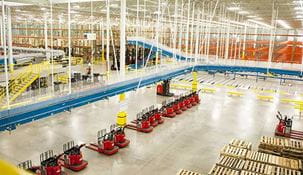
Automation
Carolina Handling can help you automate every aspect of your warehouse operation to increase efficiency.
Learn More
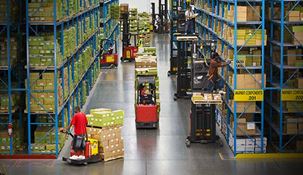
Optimization
Optimize everything in your warehouse to improve productivity and reduce operating costs.
Learn More
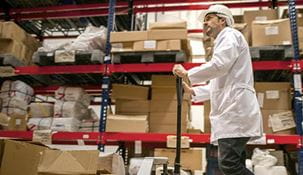
Warehouse Products
Looking for the right product for your operation? We have everything you need to do business in stock.
Learn More
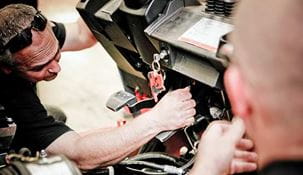
Service Maintenance
Providing superior lift truck service and maintenance for our customers is Carolina Handling's highest priority.
Learn More


